The Piper AG Planes - Agricultural Aircraft (1978)
THE PIPER AG PLANES : More airplane for the dollar.
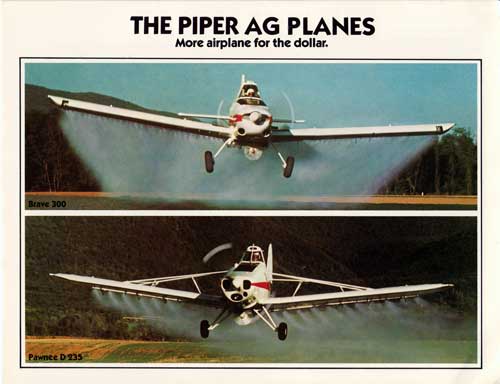
The Piper Ag Planes --
300 hp Brave and 235 hp Pawnee D
These aircraft represent more than 30 years of Piper experience in the design, manufacture and constant refinement of agricultural aircraft.
Piper pioneered the design which has become the universally accepted standard for modern ag planes. Considerations include:
- Low wing configuration for broad swath and a good downwash for proper penetration of chemicals.
- High, rear-mounted cockpit with long fuselage structure ahead for pilot protection and excellent visibility.
- Precise, reliable dispersal equipment for liquid and dry materials.
- Strong, tough, corrosion-treated and easily maintained airframes designed for quick routine cleaning and maintenance.
- Choice of airframes and 1200 hr TBO Lycoming powerplants to meet a variety of application requirements.
- Exceptional handling ease with lively responsiveness essential to ag operators.
And the Piper ag models still do the job better… more cost effectively… than any other ag planes on the market. More Airplane For The Dollar.
The Brave 300 and the Pawnee D incorporate more pilot comfort features than any other ag planes on the market.
Superb visibility, ram-air "pressure" cockpit, well placed controls, absence of cockpit clutter, professionally planned and padded instrument panel, excellent heating and ventilation, wide seat contoured for back support -- these are some of the provisions that are standard in the elevated cockpit.
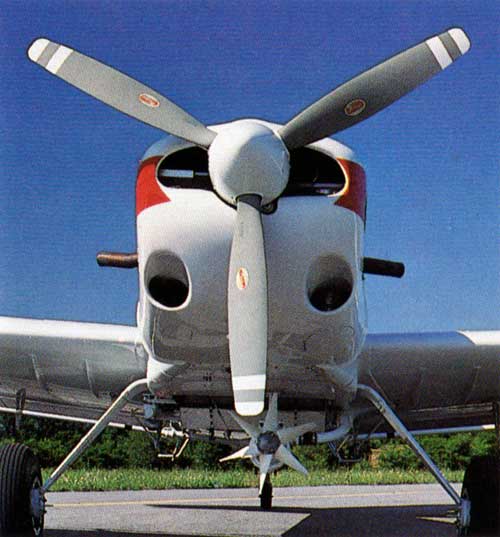
Constant speed two blade propeller with spinner is standard and a constant speed three bladed propeller is also available.
Piper agricultural aircraft have been in continuous production longer than any other ag aircraft. More than 5500 have been manufactured since 1959, during which time continuous improving and updating has taken place.
In more than 80 countries around the world, Pipers are engaged in precisely controlled seeding, fertilizing and application of solid and liquid chemicals.
They are involved every step of the way in improving, fertilizing, and seeding crops -- controlling insect pests at their various stages of development, brush and weed control, plant disease control and application of pre-harvest chemicals.
Ag aircraft advantages over ground equipment include:
- Better fuel efficiency, as low as 1/20 gallon per acre
- Faster crop coverage, with effective dispersal of solids and liquids; 6/7 acres per minute
- Capability to work when ground equipment cannot due to maturity and size of crops or wet soil conditions
- Thorough coverage without hazard of knocking down crops or compacting soil
- Safety of the carefully controlled and filtered cockpit environment
- Cost effectiveness of intensively used contracted aerial application equipment permitting farmers to minimize or completely eliminate costly ground application equipment.
Agricultural operators, pilots and their customers all benefit from the performance, precision, protection and operating economies built into the Piper models.
Brave 300 -- New and Powerful

The Brave 300 is especially designed for the operator who needs the extra performance provided by a rugged, reliable 300 hp engine with a money saving 1200 hr. TBO.
The powerplant is the Lycoming 6 cylinder, dual ignition engine with Bendix fuel injection and constant speed propeller.
This proven engine, used for many years in a variety of Pipers including the retractable Lance and the load-hauling Cherokee Six, is legendary for reliability and trouble-free operation far from maintenance bases.
In the Brave 300 it provides added performance to the ag operator faced with large acreage to cover and with demanding conditions of terrain and altitude.
You have a choice of 30 and 38 cu. ft. hoppers (225 and 275 gallons), and of quick-change spray systems in high, medium and low volume, plus an all-purpose spreader for solids in your choice of stainless steel or aluminum.
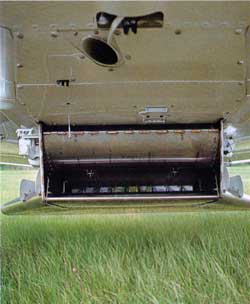
All purpose streamlined spreader, in stainless steel or aluminum, applies dry chemicals at rates from 5 to 200 lbs. per acre.
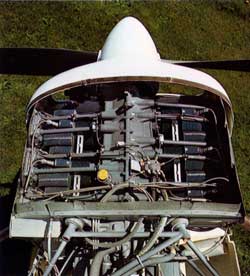
Brave's powerplant, the world-proved 300 hp Lycoming, is instantly accessible. Cowl is easily removed and spark plugs, oil filter, and air cleaner are all readily accessible.
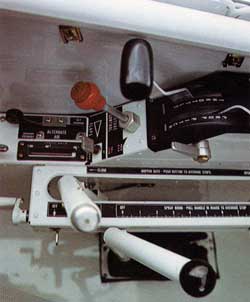
All controls for power and dispersal equipment are carefully arranged on the left side of the cockpit for easy operation by the pilot. Electric spray valve with control stick switch is available.
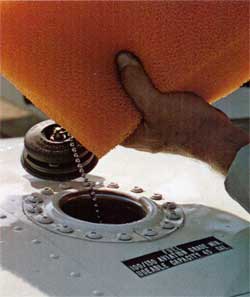
Brave's super long range fuel cells-87 usable gallons total -- are standard, and mounted in wing roots and linked to a header tank to operate as a single fuel supply. Tanks are filled with polyurethane safety foam which acts as an infinite baffle and provides maximum slosh suppression.
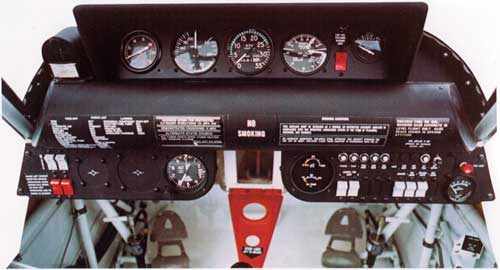
In the Brave's instrument panel, upper and lower instruments are separated by a large protective roll. Essential instruments -- air speed, spray pressure gauge, tach and manifold pressure gauge -- are in pilot's line of sight as he concentrates attention outside airplane.
Brave 300 Specifications

WEIGHTS
- Maximum take-off weight (Normal category) 3900 lbs. (1769 kg)
- Maximum take-off weight (Restricted category) 4400 lbs. (1996 kg)
- Maximum landing weight (Normal category) 3900 lbs. (1769 kg)
- Maximum landing weight (Restricted category) 3900 lbs. ( 1769 kg)
STANDARD EMPTY WEIGHT
- No dispersal equipment 2180 lbs. ( 989 kg)
- With spray dispersal equipment 2290 lbs. (1039 kg)
- With solid dispersal equipment 2290 lbs. (1039 kg)
(Standard empty weight includes: Unusable fuel, full operating fluids and full oil)
STANDARD USEFUL LOAD
(Restricted category)
- No dispersal equipment 2220 lbs. (1007 kg)
- With spray dispersal equipment 2110 lbs. ( 957 kg)
- With solid dispersal equipment 2110 lbs. ( 957 kg)
HOPPER CAPACITY
- Standard 225 gals. ( 852 L) 30 ft.3 ( .85 m3)
- Optional 275 gals. (1,041L) 38 ft.3 (1.05 m3)
MAXIMUM HOPPER LOAD
- Standard 1900 lbs. (862 kg)
WING AREA/WING LOADING/POWER LOADING
- Wing area 225 ft.2 (20.9 m2)
Normal Category
Restricted Category
USABLE FUEL
- Standard 86 U.S. gal. (325.5 L)
OIL CAPACITY
- 3 U.S. gal. (11.4 L)
DIMENSIONS
- Wing Span 38.8 ft. (11.8m)
- Length 26.8 ft. ( 8.2 m)
- Height 7.5 ft. ( 2.3 m)
Performance Without Dispersal Equipment
HIGH SPEED, OPTIMUM ALTITUDE (TAS) 148 mph (238 km/h)
CRUISE SPEEDS/RANGE (BEST POWER MIXTURE)
| Power % | Cruise Altitude | Cruise Speed (TAS) | Range with 45 Minute Reserve | |||
|---|---|---|---|---|---|---|
| ft. (meters) | mph (km/h) | Miles (Kilometers) | ||||
| 75 | 5,500 | (1,675) | 142 | (228) | 565 | (910) |
| 65 | 9,300 | (2,835) | 138 | (222) | 590 | (950) |
| 55 | 11,200 | (3,415) | 126 | (203) | 615 | (990) |
CRUISE SPEEDS/RANGE (BEST ECONOMY MIXTURE)
| Power % | Cruise Altitude | Cruise Speed (TAS) | Range with 45 Minute Reserve | |||
|---|---|---|---|---|---|---|
| ft. (meters) | mph (km/h) | Miles (Kilometers) | ||||
| 75 | 5,500 | (1,675) | 142 | (225) | 640 | (1,030) |
| 65 | 9,300 | (2,835) | 136 | (219) | 675 | (1,085) |
| 55 | 11,200 | (3,415) | 124 | (200) | 705 | (1,135) |
Ranges include fuel allowance for start, taxi, take-off, climb, cruise, descent and a 45 minute reserve.
RATE OF CLIMB AT SEA LEVEL
- 3900 lbs. (1769 kg) 770 fpm (235 m/min.)
- 3100 lbs. (1406 kg) 1100 fpm (335 m/min.)
STALL SPEED CAS (POWER OFF) 3900 LBS.
- Flaps 30° 62 mph (100 km/h)
- Flaps 0° 72 mph (116 km/h)
TAKE-OFF DISTANCE-15° FLAPS
- Normal procedures at 3900 lbs. (1769 kg)
- Ground run 960 ft. (293 m)
- Total distance over 50 ft. obstacle 1525 ft. (465 m)
LANDING DISTANCE-30° FLAPS
- Normal procedures at 3900 lbs. (1769 kg)
- Ground roll 700 ft. (213 m)
- Total distance over 50 ft. obstacle 1650 ft. (503 m)
Performance With Equipment Installed
HIGH SPEED, OPTIMUM ALTITUDE (TAS)
- Spray dispersal equipment 126 mph (203 km/hr)
- Solid dispersal equipment 119 mph (191 km/hr)
CRUISE SPEEDS/RANGE (BEST POWER MIXTURE) WITH SPRAY DISPERSAL EQUIPMENT 4100 LBS.
| Power % | Cruise Altitude | Cruise Speed (TAS) | Range with 45 Minute Reserve | |||
|---|---|---|---|---|---|---|
| ft. (meters) | mph (km/h) | Miles (Kilometers) | ||||
| 75 | 5500 | (1,675) | 118 | (190) | 460 | (740) |
| 65 | 5500 | (1,675) | 103 | (166) | 450 | (725) |
CRUISE SPEEDS/RANGE (BEST POWER MIXTURE) WITH SOLID DISPERSAL EQUIPMENT 4100 LBS.
| Power % | Cruise Altitude | Cruise Speed (TAS) | Range with 45 Minute Reserve | |||
|---|---|---|---|---|---|---|
| ft. (meters) | mph (km/h) | Miles (Kilometers) | ||||
| 75 | 5500 | (1,675) | 108 | (174) | 415 | (665) |
Ranges include fuel allowance for start, taxi, take-off, climb, cruise, descent and a 45 minute reserve at 45%.
RATE OF CLIMB AT SEA LEVEL WITH SPRAY DISPERSAL EQUIPMENT
- 4400 lbs. (1996 kg) 375 fpm (114 m/min.)
- 3500 lbs. (1587 kg) 630 fpm (192 m/min.)
RATE OF CLIMB AT SEA LEVEL WITH SOLID DISPERSAL EQUIPMENT
- 4400 lbs. (1996 kg) 320 fpm ( 98 m/min.)
- 3500 lbs. (1587 kg) 515 fpm (197 m/min.)
TAKE-OFF DISTANCE, WITH SPRAY DISPERSAL EQUIPMENT-15° FLAPS
- Normal procedures at 4400 lbs. (1996 kg)
- Ground run 1350 ft. (411 m)
- Total distance over 50 ft. obstacle 2090 ft. (637 m)
- Normal procedures at 3500 lbs. (1587 kg)
- Ground run 960 ft. (293 m)
- Total distance over 50 ft. obstacle 1385 ft.(422 m)
TAKE-OFF DISTANCE, WITH SOLID DISPERSAL EQUIPMENT-15° FLAPS
- Normal procedures at 4400 lbs. (1996 kg)
- Ground run 1470 ft. (448 m)
- Total distance over 50 ft. obstacle 2225 ft. (678 m)
- Normal procedures at 3500 lbs. (1587 kg)
- Ground run 970 ft. (296 m)
- Total distance over 50 ft. obstacle 1395 ft. (425 m)
LANDING DISTANCE, WITH SPRAY DISPERSAL EQUIPMENT
- Normal procedures at 4400 lbs. (1996 kg)
- Ground roll 715 ft. (218 m)
- Total distance over 50 ft. obstacle 1470 ft. (448 m)
- Normal procedures at 3500 lbs. (1587 kg)
- Ground roll 525 ft. (160 m)
- Total distance over 50 ft. obstacle 1065 ft. (325 m)
LANDING DISTANCE, WITH SOLID DISPERSAL EQUIPMENT
- Normal procedures at 4400 lbs. (1996 kg)
- Ground roll 710 ft. (218 m)
- Total distance over 50 ft. obstacle 1475 ft. (448 m)
- Normal procedures at 3500 lbs. (1587 kg)
- Ground roll 525 ft. (160 m)
- Total distance over 50 ft. obstacle 1065 ft. (325 m)
Pawnee D 235 - Tractor of the Sky

Piper's popular Pawnee D is powered by a ruggedized 235 hp low-compression Lycoming engine with 6 cylinders and dual ignition.
The fiberglass multi-purpose hopper has a capacity of 150 gallons of liquids or 1200 lbs. of solids. A variety of high and low volume spray systems are offered, in addition to an aluminum spreader.
The nimble Pawnee D is unsurpassed in the ability to disperse chemicals for fields close-in and with small-to-medium acreage- with exceptional economy and efficiency.
The Lycoming engine's 1200 hr. TBO and proven reliability with ease of maintenance are important operators' benefits, too.

Pawnee D 235 Specifications
| Description | Without dispersal equipment | Duster | Sprayer | |||
|---|---|---|---|---|---|---|
| Engine | Lycoming 0-540 | |||||
| HP and RPM | 235 @ 2575 | |||||
| Gross weight, lbs. (kg) | 2,900 | (1,316) | 2,900 | (1,316) | 2,900 | (1,316) |
| Empty weight, lbs. (kg) | 1,576 | (715) | 1623 | (736) | 1638 | (743) |
| Useful load, lbs. (kg) | 1,324 | (601) | 1277 | (579) | 1262 | (572) |
| Wing span, ft. (m) | 36.2 | (11) | 36.2 | (11) | 36.2 | (11) |
| Wing area, ft.' (m2) | 183 | (17) | 183 | (17) | 183 | (17) |
| Length, ft. (m) | 24.7 | (7.5) | 24.7 | (7.5) | 24.7 | (7.5) |
| Height, ft. (m) | 7.2 | (2.2) | 7.2 | (2.2) | 7.2 | (2.2) |
| Propeller diameter, in. (m) | 84 | (2.1) | 84 | (2.1) | 84 | (2.1) |
| Power loading, lbs./hp (kg/hp) . | 12.3 | (5.60) | 12.3 | (5.6) | 12.3 | (5.60) |
| Wing loading, lbs./ft.' (kg/m2) | 15.8 | (77.1) | 15.8 | (77.10) | 15.8 | (77.10) |
| Fuel capacity, gals. (L) | 38.5 | (146) | 38.5 | (146) | 38.5 | (146) |
| Usable fuel, gals. (L) | 36 | (136) | 36 | (136) | 36 | (136) |
D235 Performance
| Description | Without dispersal equipment | Duster | Sprayer | |||
|---|---|---|---|---|---|---|
| Cruising range, miles, 75% power (km) | 290 | (467) | 255 | (411) | 270 | (435) |
| Top speed, sea level, mph (kmh) | 124 | (200) | 110 | (177) | 117 | (188) |
| Cruising speed, 75% power,mph, (kmh) | 114 | (184) | 100 | (161) | 105 | (169) |
| Stalling speed, max. gross, flaps down, mph (kmh) | 61 | (98) | 61 | (98) | 61 | (98) |
| Stalling speed as usually landed, mph/1700 lbs. (kmh/772 kg) | 46 | (74.00) | 46 | (74) | 46 | (74) |
| Take off run, ft. (m) | 785 | (239) | 956 | (292) | 800 | (244) |
| Take off over 50 ft. obstacle, ft. (m) | 1350 | (412) | 1470 | (448) | 1370 | (418) |
| Landing roll, max. gross, ft. (m) | 850 | (259) | 850 | (259) | 850 | (259) |
| Best rate of climb speed, mph (kmh) | 83 | (134) | 83 | (134) | 83 | (134) |
| Rate of climb, ft. per min. (m per min.) | 700 | (214) | 500 | (153) | 630 | 192 |
| Fuel consumption, gal./hr., 75% power (L/hr.) | 14 | (53) | 14 | (53) | 14 | (53) |
Note: The performance figures are based on maximum weight, except as noted, and are the results of flight tests of an airplane conducted by Piper Aircraft Corporation under factory controlled conditions and will vary with individual aircraft and numerous factors affecting flight performance.
Brave 300 -- strongly built, pilot-protective, corrosion-proofed, easy to maintain and repair.
- Quick-change spray system, with high, medium and low volume versions, can apply liquid chemicals at rates up to 19 gallons per acre in variable swath width to 80 feet. Booms mounted aft of wing minimize drag and are in full view of pilot.
- Landing and taxi lights, anti-collision wingtip strobes, navigation and instrument lights are all available in the Brave.
- Aerodynamically clean, full cantilever wing, a carry-through structure that does not interfere with hopper design, features high strength main spar attachment, laminated spar construction and energy-absorbing leading edges and tips.
- Landing gear is rugged and simplified. Large 8:50 x 10 tires and 10" Scott Tailwheel facilitate operations from rough or soft fields. Hydraulic disk brakes (toe operated) are easily and quickly serviced.
- Wire deflector in front of windshield is supplemented by a heavy steel cable which runs back to rudder tip to deflect utility wires. Main landing gears are also fitted with wire cutters.
- Raised cockpit is 38" wide allowing for maximum pilot comfort. Seat is well contoured with lumbar support and ventilation. Seat and canted rudder pedals are adjustable.
- Full shoulder harness with inertia reel permits unrestricted freedom of movement.
- Sealed cockpit area uses filtered "ram air" with positive cockpit pressure to provide excellent ventilation.
- High-mounted cockpit, sloping nose, pageWrapper-around rear window and overhead window give pilot "super" vision. Doors on both sides have quick-release hinges for fast emergency exit.
- Solid one-piece heavy duty cockpit floor is sealed and uncluttered.
- An optional high-volume heater in sealed cockpit area eliminates need for cumbersome clothing on chilly mornings.
- Reinforced fiberglass hopper is available in 30 and 38 cu. ft. versions. Large top hatch expedites loading of solids, and liquids can be loaded through the hatch or the optional side loader.
- Plastic loading door is unpainted and hopper is translucent so pilot sees contents. Exterior sight gauge has been added for convenience during ground loading of liquids. Clear glass window in back of hopper aids pilot in monitoring contents.
PIPER
More Airplane For The Dollar
Entire plane can be assembled wings removed, fuselage stripped to bare frame, canopy and hopper removed readily.
Steel truss fuselage structure is heli-arc welded chrome moly steel tubing graded in strength and stability for energy absorption.
Durable metal and plastic covering used throughout. Vulnerable areas such as wing and empennage tips and rear belly panel are removable; easily repaired and serviced.
Side and belly pan removed with quick-release fasteners in minutes, for access to every fuselage component.
PIPER
More airplane for the dollar.
Piper Aircraft Corporation, Lock Haven, PA 17745
Member of GAMA
A Bangor Punta Company
GG Archives REF: BPPAC-003-1978-C-BRO

